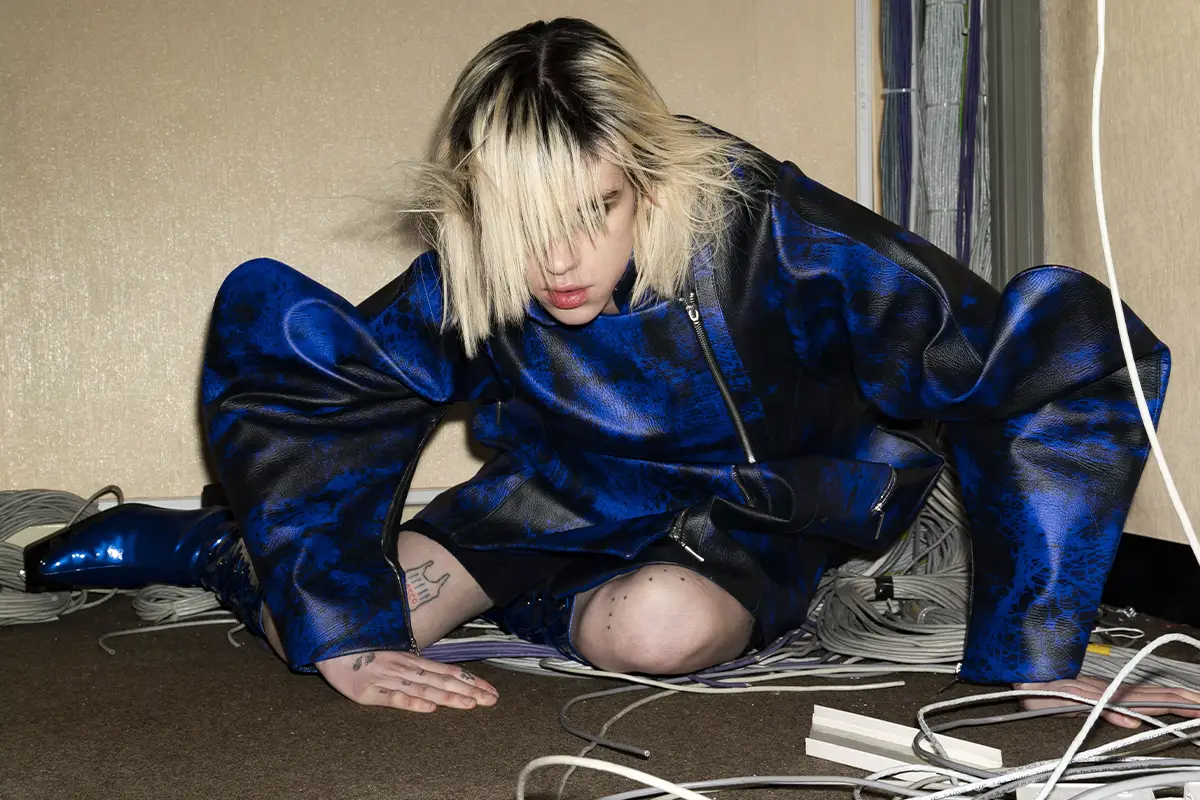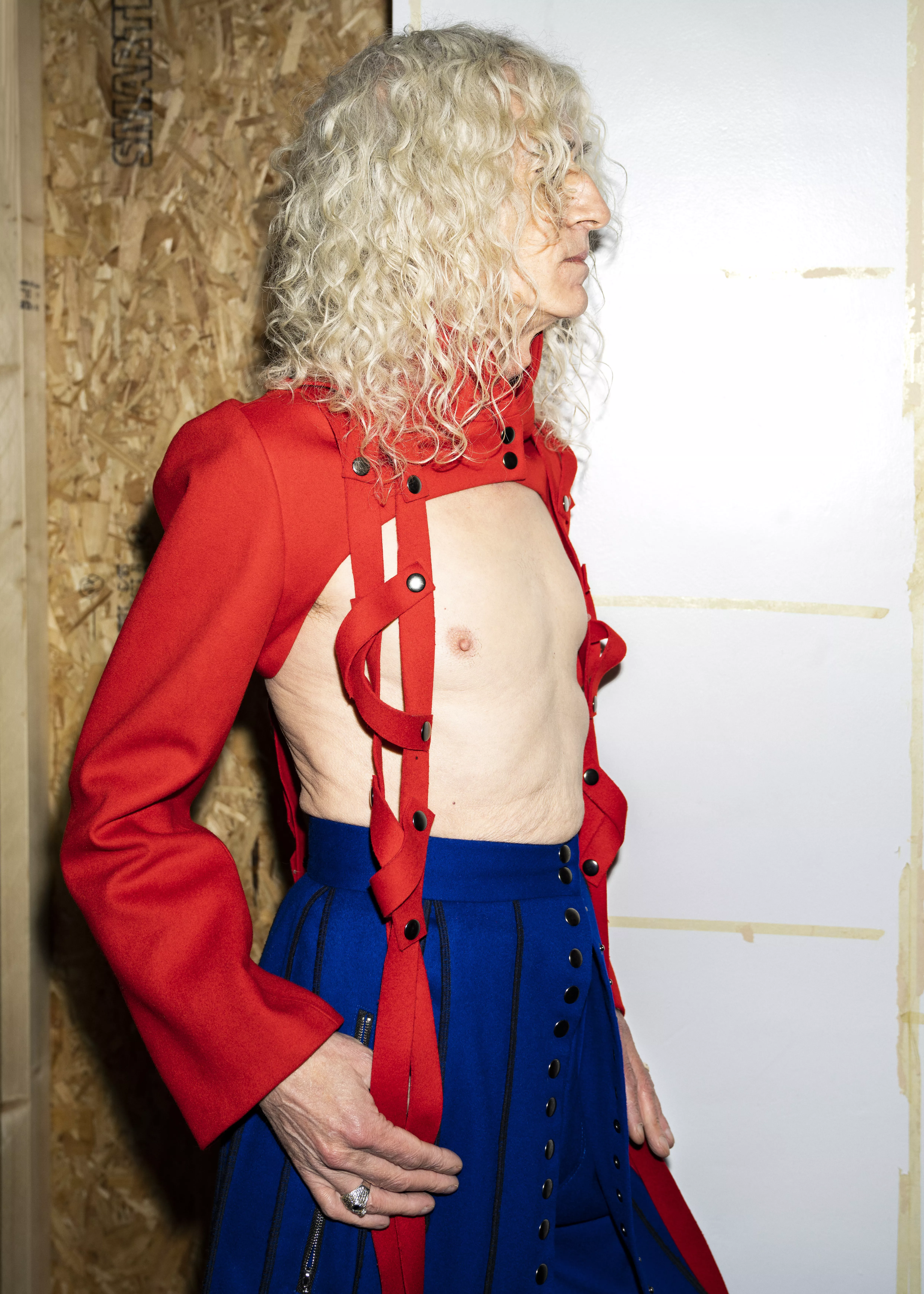«It’s a make do and mend mentality, an ad hoc way of working, of finding materials – taping together rather than sewing. It’s that crafty, Nineteen Eighties approach to fashion», Maximilian Raynor
Woolwich, South East London: Maximilian Raynor
In Woolwich, South East London, is an office block that to the untrained, or unbeknownst eye, might read as abandoned. On each and every of the numerous floors, lay rooms emptied of their modular office furniture and corporate apparatus, now shells populated only by gray tiled carpets and suspended ceiling squares. Their papered walls peel at the edges, the carpet lifting along the walls. Yet within these rooms also exists an intricate network of creatives, «a hub of creative energy, positioned in such a derelict space, so rough around the edges».
On one such floor of this all but abandoned office block, where rooms are rented out as subsided studios by arts and culture sponsors SET, a tattoo artist runs their practise, while in the subsequent room a ceramicist sculpts. In another space resides a multidisciplinary artist specializing in metal works, and just down the hall is Maximilian Raynor. Only a few months ago, the room the 24 year old fashion designers’ business inhabits, similarly resembled the squalor that runs throughout the rest of the building.
A self-sustaining business: seven month after graduating
While Raynor might operate out of the Woolwich tower block, it also has to host the meetings with clients, buyers, stylists and V.I.P’s that are essential to running a burgeoning brand. Most incongruous activities considering the surroundings, except that Raynor has somewhat overhauled the space.
White washed, populated with a large cutting table littered with textile shears, sewing machines and meters of fabric in Raynor’s most popular colors and finishes, his studio is fully functioning. «It’s self-sustaining at this moment in time, the brand and the money made from it is enough for the rent, and that’s all I can ask for at this stage». This, from the designer, comes less than seven months after the release of his BA collection.
The Ballad of Two Lovers: In Three Parts
In May, 2022 Raynor presented his debut collection ‘The Ballad of Two Lovers: In Three Parts’. The 24-year-old dreamed up a rabid fairytale for the modern-day; riffing on romantic tropes of imagined heroines and articulating a modern love story in a nine-piece, semi-couture collection.
It aimed to address an uneasy sense of paralysis he perceived in «the creative space at large», the characters he developed and dressed; a mélange of reimagined Shakespearian stock characters, representative of a self-consumed generation of autocrats unable – or unwilling – to look beyond their own world to enact real change.
Following the collections’ exclusive release with editrix Katie Grand’s Perfect Magazine, Raynor embarked upon the effort of making the Raynor brand a reality. His daily schedule working with his small, ad-hoc team out of the decrepit creative dynasty, carrying out the minutiae so essential to staying afloat, is punctured with elation of «made-it moments». The brand’s fashioned gowns have walked the the red-carpet at Cannes, appeared on runways from Shenzhen to London to Rwanda – the latter attended by the then Prince Charles, now King of England – and one such style was published in Pirelli’s 2023 calendar on Adut Akech.
No to playing it safe – Maximilian Raynor
It is this dichotomy that perhaps best represents Raynor’s practise, and intentions as a designer. Unpretentious materials, unfussy spaces, an unassuming attitude set opposing ultra-luxe bespoke gowns. The rawness of Raynor’s creative practice isn’t only imbued in his work through his residency in Woolwich, but is evident in the way in which he operates writ large.
«I don’t believe in playing the long game, in positioning myself in a way now to allow for an organized outcome in the future». The Central Saint Martins Fashion Masters programme, on which Raynor enrolled last September, has been probing, encouraging its pupils to ‘go back to basics’ and abandon their often curatorial, and occasionally contrived perspectives.
Maximilian Raynor, the brand
«It’s a make do and mend mentality, an ad hoc way of working, of finding materials – taping together rather than sewing. It’s that crafty, a Nineteen Eighties approach to fashion, and it is rewarding to work that way. It’s about doing it yourself, and having that handwriting of what you do in the heart of the piece. I don’t want it (Maximilian Raynor, the brand) to be this produced thing».
He has no qualms about photographing and recording his work at every stage, sharing fragmentary references or ideas about their collection long before they reach their eventual culmination. «I’m just open – I don’t want to be marketed by other people, I don’t want to self-edit too much, and I don’t want to try to present this manufactured processed version»
Katie Grand, Amanda Harlech and Mandi Lennard
Sharing his work has led to his industry kudos, with Raynor being welcomed by industry leaders including the aforementioned Katie Grand, Amanda Harlech and Mandi Lennard.
Before entering his final year on the BA Fashion programme at Central Saint Martins, he had received sponsorship from Tommy Hilfiger via a mentorship programme, spent a week working in the late Dame Vivienne Westwood’s studio (be it at age eleven), served as menswear assistant at JW Anderson, and formed a close working relationship with vintage legend, Rellik co-founder Steven Philip, with whom he started up Philip’s latest endeavor – an archive studio in Brighton – over Britain’s 2020 lockdown.
Bimini and Black Peppa, Ellie Goulding and Roisin Murphy
Beyond his industry mentors, Raynor has developed a roster of patrons for his namesake label; dressing drag artists – Bimini and Black Peppa amongst them – certified superstars Ellie Goulding, Roisin Murphy and more names. He isn’t spoilt by the success; the finances of a young fashion designer keeping him tethered to the sharp reality of survival as an independently owned and ran brand; the contrast between his collections against the building they are designed inside; balancing on that familiar knife edge young designers so often find themselves on in their fledgling years between surviving and thriving.
He is quick to recognise the illusory nature of ‘success’ in fashion – fast to dispel notions of grandeur based on the cache of celebrity: instead, Raynor pays his dues to the occasions on which he was able to unreservedly learn about design, the hours spent conducting what he calls «‘background graft’ – standing in rooms over the years with all these people and just seeing a little sleeve on a John Flett, or noticing a detail on a Comme Des Garçon shirt. Those things, I think, in the long run are what will make me a better designer than having dressed people for the Cannes red carpet».
A democratized version of Fashion
The approach Raynor takes to his practice, the fast and loose sharing of work so at odds with his peers, is continued within the more mundane aspects of running a business. Maximilian Raynor’s clothes aren’t available to be borrowed freely by photographers and stylists for editorial shoots: the industry standard at present.
Instead, they are loaned out for a minimal fee, «Creating a more democratized version of what fashion can be like is a bullet we should bite». The designer’s samples per se, are his product – and his attitude towards creating a monetised business is representative of his desire to revolutionize the sphere in which he works.
Maximilian Raynor
Maximilian Raynor is a Central Saint Martins graduate. He has represented his collections in New York, China and Rwanda.
Designer and Creative Director: Maximilian Raynor
Photographer: Carlos Duro Yague
Interview: Jess Worth
Talents: Safe Crane & John Foley
Make Up: Dan Delgado
Hair Stylist: Kieron Fowles
Set Designer: Fillo Deportaberta
Casting Director: Alexis Ocon on GazeCast
Movement:Sabrina Wong
Production: Amber Lorrell
First photo assistant: Solar Klinghofer
Second photo assistant:Thea Levine
Set assistant: Robert Abad




















